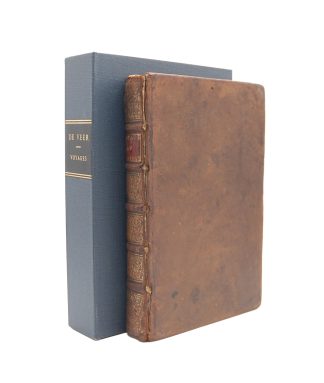VEER, Gerrit de.
A GREAT ASTRONOMER’S COPY
Trois navigations admirables faictes par les hollandois et zelandois au septentrion…
Paris, chez Guillaume Chaudière, 1599£10,500.00
8vo. pp. [iv] 366 (ie. 368). [-]1, *1, A-Z8. Roman letter, some Italic. Small typographical ornament on title, grotesque woodcut head and tail pieces, woodcut initials, “Lalande 13 Juin 1794” at head of pastedown, notes in Lalande’s hand concerning astronomical instruments and degrees of latitude and longitude including a small diagram on pastedown and ffep, further notes on rear endpapers including a diagram of a compass, a few notes in a slightly different hand on the same pages, ‘notes de m. Lemonnier’ at head, side notes in Lalande’s hand. Age yellowing, some browning in places, rare marginal mark or stain. A very good copy in mid C18th calf, spine with raised bands, gilt ruled in compartments with repeated scrolls gilt, red morocco label gilt, upper joint cracked, lower damaged at head, a.e.r. in folding box.
The rare second edition of the French translation of De Veer’s account of three most important polar voyages in search of the Northeast Passage to China and the East Indies, commanded by Willem Barents, with exceptional provenance; from the library of the celebrated astronomer Joseph Jérôme de Lalande including his notes and side notes. The three expeditions recounted here took place in 1594, 1595, 1596-1597. The commander of the three voyages was the pilot Willem Barents of Amsterdam. Gerrit De Veer himself only took part in the last two expeditions and described the first expedition from Barents notes. The account of the third voyage, during which the Dutch sailors had to winter at Novaya Zemlya, occupies more than half of the work. The three accounts include de Veer’s eyewitness journal, as a crew-member, of Barents’ disastrous final voyage in 1596-97: a tale of extreme hardship and danger and it describes in the form of a daily diary the crew’s winter in a hut built from ship’s timbers on the coast of Novaya Zemlya, after their ship had been crushed by ice. It is the earliest recorded wintering this far north.
“These voyages proved Barents one of history’s greatest arctic navigators. The first foray began in 1594, when Barents directed his ships down the length of Nova Zembla. Blocked by seasonal ice from further passage, the Dutch retraced their course to Vaigatz and passed through the Kara Sea as far as the latitude of Ob. The relative success of this effort prompted another attempt the following year. This time, however, an unusually severe winter kept the straits between Vaigatz and the mainland packed with ice all summer, and the voyagers returned to Holland after little success. Accompanying Barents as supercargo on both of these expeditions was the famed Dutch traveler Jan Huyghen van Linschoten. It was the third voyage in 1596 that ranks among the “hardiest achievements of all Polar exploration”. Barents began by attempting to sail directly across the Pole. Though he was blocked by pack ice, along the way he became the first European to make contact with the Spitsbergen Islands. Steering back for Nova Zembla, the Dutch passed the farthest point they had reached on their first voyage in 1594, and pressed on around the northern tip of the island. Here their ship was crushed in the ice, and the crew was forced to wait out the winter. It was a winter of great misery, during which a number of the crew froze to death and several were eaten by polar bears. When the summer ice failed to release his ship, Barents directed the remaining members of this crew in a difficult voyage in an open boat; he died before they safely reached Russian territory” K Hill. “The Hill Collection of Pacific Voyages.”
Joseph Jérôme Lefrançois de Lalande’s copy; his autograph on pastedown, with his notes concerning astronomical instruments and degrees of latitude and longitude taken from the voyages on pastedown and ffep. It is not individually listed in the catalogue of the sale of his books in 1808 that took place a year after his death at the College de France. Lalande was a celebrated astronomer and at the centre of French intellectual circles during les Lumières. He was close to Voltaire, Helvetius, and many others. He held the chair of astronomy in the Collège de France for forty-six years. His publications in connection with the transit of Venus of 1769 won him great fame. He was also a Freemason and founded the Lodge of “Les Trois Soeurs” in Paris, influential in the American war of independence: In 1778 Lalande arranged for Benjamin Franklin and John Paul Jones to join; Franklin became Master of the Lodge in 1779, and was re-elected in 1780. When Franklin, returned to America to participate in the writing of the Constitution, Thomas Jefferson, a non-Mason, took over as American Envoy. Lalande was a renowned atheist but still harboured priests fleeing the revolution at the College de France. It is possible that Lalande obtained this copy from his friend, another famous astronomer of the same period, Pierre Charles Lemonnier, from his note on rear pastedown ‘notes de m. Lemonnier’.
A very rare edition of these important voyages with remarkable provenance.
BM STC, Fr. C16th p. 436. USTC 20588. Geoffroy Atkinson “La littérature géographique française de la Renaissance: Répertoire bibliographique” no. 401. Alden 599/92. JCB I:377. Rothschild 1962. Tiele-Muller 96.In stock
















